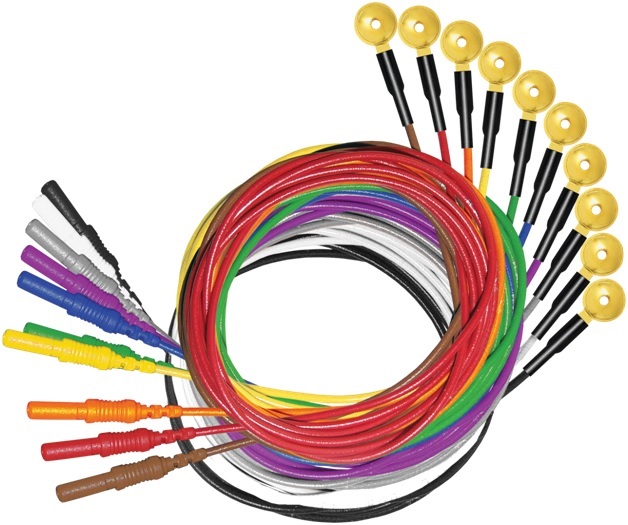An EEG, or electroencephalogram, is a test intended to monitor the electrical activity of the brain, typically with the intention of identifying pathological signs or pathological graphoelements associated with epilepsy, narcolepsy, and Alzheimer’s Disease, although they may also be prescribed for patients that have other brain disorders.1
In order to record the electrical activity or brain waves, sensors known as EEG electrodes are affixed to the scalp of a test patient, typically in conjunction with a special conductive paste that helps facilitate the recording.
There are several different types of EEG electrodes, and the type of electrode that is used, along with the preparation for the procedure, can impact the data quality of an EEG.
How EEG Electrodes Impact EEG Data Quality
One of the central issues surrounding EEGs is what is known as “electrode-scalp impedance.” Impedance is a term that refers to the electrical resistance of the scalp, measured in kΩ. The higher the electrical impedance of the scalp, the greater will be the impact on the recording.
The outer layer of the epidermis offers the highest levels of impedance. Typically, to combat this issue, the administrator of the test conducts “scalp abrasion,” in which the topmost layer of the skin is removed, in order to lower electrode-scalp impedance and deliver a more accurate recording.
However, with scalp abrasion there comes the concern of infection. A study published recently found that bacteria representing a potential risk of infection were present on 22.6% of cleaned rEEGs-CELWs. This study may suggest that there is some merit to the use of single-use EEG electrodes, or that additional infection-reduction interventions are necessary. More research on the risk of of scalp infections following abrasion may be warranted.2
The use of quality EEG electrodes (such as disposable gold cup electrodes which can reduce the risk of skin infections) as well as a thorough understanding of electrode-scalp impedance and the input impedance of modern differential amplifiers can eliminate concerns about impedance as well as infection.
EEG electrodes used to take the recording should be free of inherent noise and drift; silver, silver chloride and gold disk electrodes are best, though other electrode materials and pastes can be effectively used.3
Passive EEG Electrodes
Passive electrodes are typically made of silver or silver chloride or gold and are applied to the scalp with a conductive paste. Scalp abrasion is common when using passive EEG electrodes.
The quality of silver or gold EEG electrodes is critical to the capture of a faithful signal. Silver, gold and silver chloride are non-toxic and potentially reusable with adequate disinfection, allowing them to be reused many times.
Silver EEG electrodes are also known for their excellent electrical conductivity, stability, and low offset voltage and noise. Because of these traits, they produce little electrode-scalp impedance.4
Dry and Sponge Electrodes
Another type of EEG electrode is known as a “dry” electrode. These electrodes are intended to be applied in the absence of the conductive gel or paste previously mentioned.
Preparing the electrodes, or the cap that accompanies them, with electrode paste or gel, is a time-consuming process. It also has the added drawback of adversely affecting patient comfort, as the gel or paste will leave the patient’s hair and scalp wet and messy after the procedure.5
With some dry electrodes, superior geometry and adjustable length enable sufficient patient-electrode contact to deliver a high-quality EEG recording, even in the absence of gel or paste, with low electrode-scalp impedance.
One more type of EEG electrode configuration is known as a sponge-based system, which also typically uses silver or silver-chloride electrodes held in place with a net.
This system, like the one previously mentioned, offers a high degree of flexibility and speedy patient preparation, which can be very beneficial in time-constricted situations.6
Quality EEG Electrodes, Extenders, Conductive Paste, and More

Taking accurate biosignal recordings hinges in part on the use of quality equipment. Lifesync Neuro specializes in the production of high-quality EEG electrodes, extenders, conductive pastes, and more.
Our gold cup EEG electrodes, made with Kevlar wires and available in a range of lengths, feature a design that is optimized for attachment and patient comfort, with low-profile metal discs and anti-tangle lead wires.
They also feature a watertight design and Kevlar reinforcement for long life and are made without BPA, DEHP, or natural rubber latex.
For more information about our EEG electrodes and other high-quality medical equipment, please visit the previous link, get in touch with us at 1-800-358-2468 or contact us online.
References:
- “Electroencephalogram (EEG).” https://www.hopkinsmedicine.org/health/treatment-tests-and-therapies/electroencephalogram-eeg. Retrieved November 28th, 2022.
- Nancy M. Albert, James F. Bena, Charlotte Ciudad, Nowai Keleekai-Brapoh, Shannon L. Morrison, Karen Rice, Ellen Slifcak, Jack C. Runner,
“Contamination of reusable electroencephalography electrodes: A multicenter study,
American Journal of Infection Control,”Volume 46, Issue 12, 2018, Pages 1360-1364, ISSN 0196-6553, https://www.sciencedirect.com/science/article/abs/pii/S0196655318306734 Retrieved December 1, 2022.
3. Sinha, Saurabh R.; Sullivan, Lucy; Sabau, Dragos; San-Juan, Daniel; Dombrowski, Keith E.; Halford, Jonathan J.; Hani, Abeer J.; Drislane, Frank W.*; Stecker, Mark M.. American Clinical Neurophysiology Society Guideline 1: Minimum Technical Requirements for Performing Clinical Electroencephalography. Journal of Clinical Neurophysiology: August 2016 - Volume 33 - Issue 4 - p 303-307 doi: 10.1097/WNP.0000000000000308. https://journals.lww.com/clinicalneurophys/Fulltext/2016/08000/American_Clinical_Neurophysiology_Society.3.aspx Retrieved December 1st, 2022
4.Grundlehner and Mihajlović. “Electrodes and Contact Impedance.” https://www.sciencedirect.com/topics/biochemistry-genetics-and-molecular-biology/silver-chloride. Retrieved November 28th, 2022.
5.Noronha, César. “A Brief Introduction to EEG and the Types of Electrodes.”
6.N/A. “Contamination of Reusable Electroencephalography Electrodes: A Multicenter Study.” https://www.sciencedirect.com/science/article/abs/pii/S0196655318306734 Retrieved December 1, 2022.

